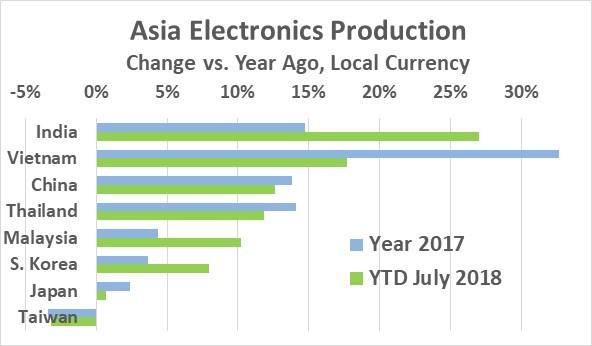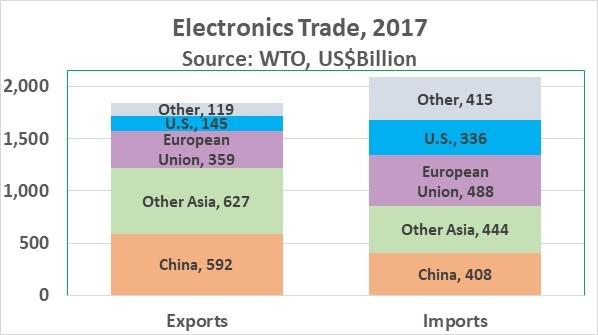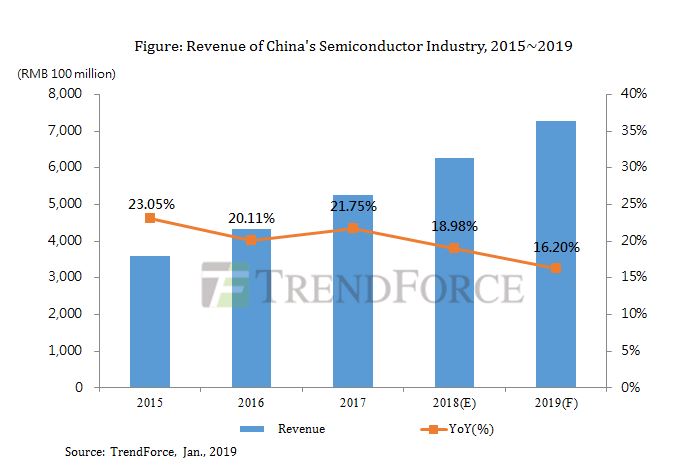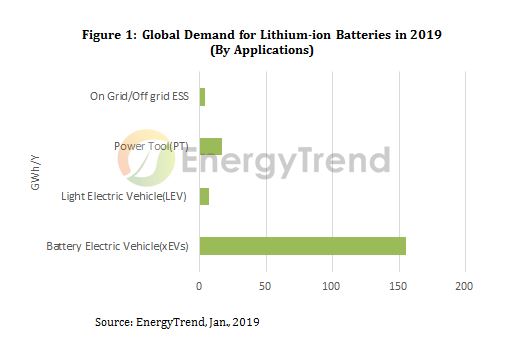Electronics healthy but trade wars loom
Production of electronic equipment is healthy, reports Semiconductor Intelligence. According to the analyst company, China, the largest electronics producer, showed three-month-average change versus a year ago (3/12) of 13.8% in August.
Growth for China has been in the 12%-15% range since January 2017, picking up from the 8%-11% range in 2016. South Korea’s electronics production has been more volatile, but was more than 12% in June and July; while the United States has shown accelerating growth since turning negative in 2016.
European Union (EU) total industrial production growth has been in the 2%-3% range from April to August, slowing from 5% earlier in the year. “Our global index of electronics production has been relatively robust in the last two years, in the 7%-9% range since January 2017,” says Semiconductor Intelligence.

Electronics production change in key Asian countries has been mixed. India and Vietnam have led with way, with India’s electronics growth accelerating from 15% in 2017 to 27% year-to-date through July 2018. Vietnam has decelerated from 33% growth in 2017 to a still robust 18% year-to-date.
China and Thailand have maintained growth in the 12%-14% range over the last year and a half. Semiconductor Intelligence believes India and Vietnam will continue to outperform other Asian countries because of their low labour rates and improving infrastructures.

Total electronics exports in 2017 were $1.8 trillion while imports were $2.1 trillion, according to the World Trade Organization (WTO). China continued as the largest electronics exporting country in 2017 at $592 billion, says Semiconductor Intelligence. However, the total other Asian countries became larger than China at $627 billion. China was also the largest importing country with $408 billion in 2017. The U.S. was second at $336 billion.

The U.S. and China are currently in a trade war, with each country imposing tariffs on imports. The US is also renegotiating the North American Free Trade Agreement (NAFTA). A preliminary agreement was reached with Mexico and discussions are on-going with Canada.
According to the US Census Bureau, the majority of US electronics imports in 2017 came from China at 59%. Mexico was the second largest source of imports at 18%. Most of the rest was from other Asian countries at 19%.

“Electronics and semiconductors are truly global industries. Free trade is necessary to keep these industries running efficiently. Hopefully the current trade issues can be resolved in a reasonable time,” Semiconductor Intelligence concludes.
在线留言询价

Revenue Growth in China's Semiconductor Industry Would Slow Down to 16.2% in 2019 due to Pessimistic
- 一周热料
- 紧缺物料秒杀
| 型号 | 品牌 | 询价 |
|---|---|---|
| BD71847AMWV-E2 | ROHM Semiconductor | |
| CDZVT2R20B | ROHM Semiconductor | |
| TL431ACLPR | Texas Instruments | |
| RB751G-40T2R | ROHM Semiconductor | |
| MC33074DR2G | onsemi |
| 型号 | 品牌 | 抢购 |
|---|---|---|
| ESR03EZPJ151 | ROHM Semiconductor | |
| BP3621 | ROHM Semiconductor | |
| IPZ40N04S5L4R8ATMA1 | Infineon Technologies | |
| TPS63050YFFR | Texas Instruments | |
| STM32F429IGT6 | STMicroelectronics | |
| BU33JA2MNVX-CTL | ROHM Semiconductor |
- 周排行榜
- 月排行榜
AMEYA360公众号二维码
识别二维码,即可关注


请输入下方图片中的验证码:

























